- Discoveries (3)
- Events (3)
- Mediterranean notes (3)
- Perspectives on country living (1)

MEDITERRANEAN LANDSCAPE ART
Rome and Venice
In early May 2012, I presented my new book Mediterranean Landscape Design (Thames and Hudson) in Rome and Venice to members of two Italian garden clubs : the Giardini aperti (www.giardiniaperti.it) and the Garden Club of Venice, baptized the Wigwam club in the 1970s by ecologist founders who admired Native American attitudes to nature (www.giardini-venezia.it/). My fairy godmother for the whole week was Italian garden journalist Ida Tonini, born in Venice but now living in Rome. She had already helped me in the preparation of this book, especially for the chapter on Venice. I often felt like Lewis Carroll’s Alice, zigzagging my way from event to event, feeling sometimes very big and sometimes very small, never knowing what would happen next, but confident it would always be something marvellous. There was a spirit of Romantic comedy throughout—beauty enhanced by shared laughter.
For the first three days, I stayed in Ida’s apartment in the heart of Rome, with a rooftop terrace and a view back towards the Pincio hills.
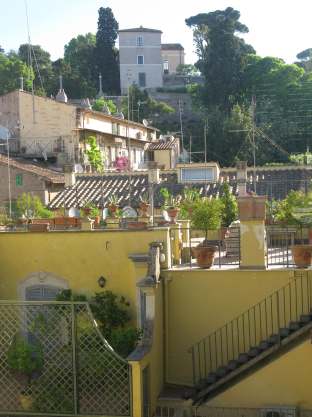
Pincio view in Rome
On my first day, she whisked me off to the Villa d’Este, which I had not seen for forty years. This Roman Renaissance water garden, made to impress and intimidate, provided one inspiration for the park at Versailles which I will see in June. I generally work with modern, more private gardens but welcome a chance to brush up on the classics. It is located in Tivoli, a town known for centuries for its lovely views and pure water, now built up in a rather ugly fashion. The Villa d’Este is a world in itself, however, and the gardens, planned for both majesty and surprise, beauty and humour, were not disappointing. They now function like a successful public garden, as full of school children as of foreign tourists. Their complex waterworks are now inoffensive--no more unexpected showers to ruin court finery. The elaborate sculpture has unfortunately been eroded by disease and weather and in any case few visitors keep in mind the original iconography. Yet the monumental proportions and masses are still impressive, and everywhere I had a sense of recognition—so often has this Roman Renaissance garden been imitated in later times.
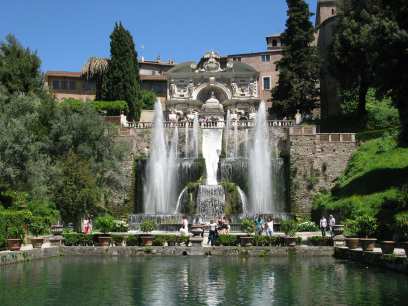
Villa d'Este gardens
Terraced gardens have intrigued me in many books (and I live in one myself). Here I found the original vertical axis cutting straight from the house to the bottom of the garden, suddenly unveiled to visitors arriving from below, as at Serre de la Madone in Menton. The bilateral symmetry thus created, with surprise variations at the ends of each terrace, has been a model for many Riviera gardens. Similarly I remember other, later gardens using rills down each side of the main central staircase. I liked all the sculptures of figures emerging from walls in the depths of grottoes, half-formed humans taking shape from the natural flow. Back to Rome at the rush hour—I was glad not to be driving! We were invited to dinner that evening, a last minute arrangement, in a Renaissance palazzo off the Piazza Venetia, magic at twilight.
The next day was my lecture, organized at the British School in Rome, built by Edward Lutyens right on the edge of the Borghese Gardens. My audience was knowledgeable and gracious. My excellent translator was landscape architecture professor Dr. Paolo Camilletti, whose fifty students trouped in to fill up the back rows.
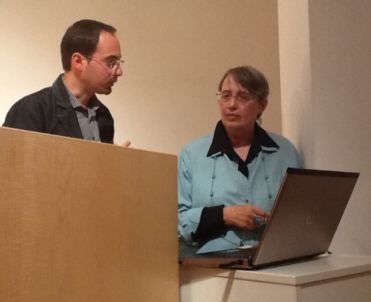
Lecturing in Rome
Drinks in the school gardens were followed by dinner was in a typical Roman bistro, fritta mista and saltimbocca, with the main club members, each very different, with only one Englishwoman. For the whole week I was immersed in Italian, which I had brushed up on a bit before leaving. My accent is so dreadful that people pleaded “Speak EENGLISH” but it helped me understand a bit of what was being said around me.
Breakfast the next day was in a chic café down the street, full of surprisingly giant plaster gods and goddesses—a former artist’s studio. My hostess and I went from Rome to Venice by fast train, about three and a half hours. We arrived in stormy weather, struck by the light and the smells of the lagoon from the first minute outdoors. Here all the arrangements had been made (in generous response to Ida’s suggestion) by another garden journalist, also a native Venetian, Mariagrazia Dammicco, president of the Wigwam Club. She is also finishing a new book on Venetian gardens with photographer Gabriele Kostas, who later took the pictures of my presentation. Mariagrazia also organizes visits to gardens in Venice on a private basis (giardinistorici.ve@wigwam.it or mgdammicco@hotmail.com). She had arranged for me to stay with a member of the club in the quiet Cannaregio area, near the Ghetto. My hostess was a French woman who had grown up in Venice, knowledgeable about the city’s socioeconomic history. She lives not in a palazzo but in working class housing from the 1930s. My view here gave onto a patchwork of the kind of “vernacular” gardens I wrote about in the book, productive and appealing all at once.
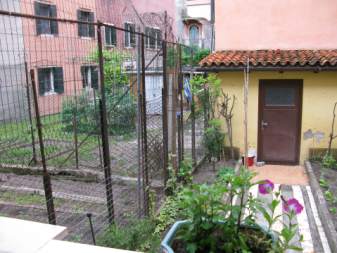
Canareggio back gardens
On arrival, Ida and I had lunch in a canal-side trattoria in Cannaregio. Ida joked with the waitress in Venetian. It turned out the waitress is one of two sisters who own the place and Ida knows them well. There was a family dinner party that night where my Italian failed me, but where I loved the moment when one woman stood to proclaim Manzoni verses against Napoleon and everyone joined in rousing refrains. This house has a lovely garden from the 1920’s and there is a picture of its water gate in my book.
In Venice, I enjoyed two small museums—the Ca d’Oro with its inner courtyard garden and the Fortuny museum, situated in a beautiful palazzo where it seems Ida engaged in amateur theatricals as a teenager! Besides its important displays on the history of fashion, it has a small separate room with a light sculpture by James Turrell, Red Shift from 1995—another delightful surprise.
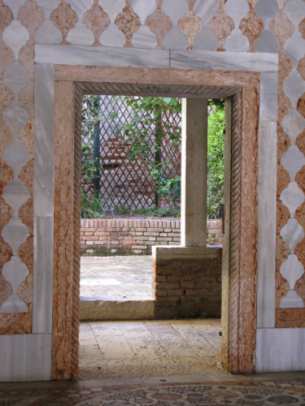
The Ca d'Oro courtyard
My presentation in Venice was nearly a disaster because it was held in the Serra dei Giardini di Castello, the greenhouse of the Biennale site, on a loggia above the cafeteria. The noise from below was nearly deafening. I do not have a good voice for this kind of situation, even with a microphone. But luckily help was present. Guiseppe Rallo, the landscape architect who had restored the gardens of the Palazzo Soranzo Capello (the main garden cited in my chapter on Venice) spoke for me, and very well. He had only had my book in hand for 24 hours but had studied it enough to give a good summary of the main points including quotations! I did not need to say much but my few points were translated by Sr Rallo’s wife, Giuliana Giusti, a well-known linguist just off to give seminars in Cambridge. She absolutely refused to translate my compliments about her husband’s work, but I hope the audience got them anyway.
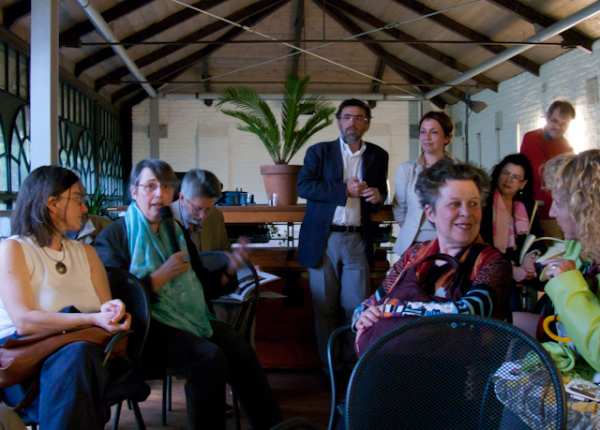
Louisa Jones among friends in Venice Photo © Gabrielle Kostas
For my last day, Mariagrazie Dammico surprised me with an appointment on the Guidecca to see a most unusual garden. Not least because the owner was for years assistant to the Austrian architect Hundertwasser, last owner of the famous Eden gardens that belonged (around 1900) to the brother-in-law of Gertrude Jekyll. Eden wrote a book about their life there that I quote a lot in mine. These now legendary gardens are now extremely difficult to visit and I am told that nothing is left but a group of magnificent cypresses, visible from some distance. Hundertwasser bought the site when it was already overgrown with brambles and weeds, and encouraged its further decline because he admired nature at its wildest. Why, I asked his former assistant, did he buy the Eden garden to begin with, as it was not intended to be a wild garden at all? She replied that it had still a house on it with a beaten earth floor, and Hundertwasser, at that stage, loved the idea of living in touch with the bare earth.
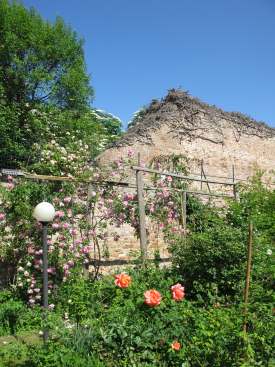
Private garden on the Guidecca
This was not, however, the garden I saw. The artist’s assistant has made her own kind of place, almost a Norman cottage garden, full of flowers—roses, hollyhocks and clematis against brick walls. Nothing edible and nothing in winter. It is obviously much loved. She believes very strongly in plant telepathy and communes with her garden, even when far away. She can consult with it in a nursery, for example, to make decisions about what it wants and needs. She feels that, far from controlling her garden, she is there to serve it. She is also making a courtyard garden for a new hotel that her son is building in the Cannarregio to be called, I fear, the Carnival Palace hotel.
But one of my nicest experiences on this last morning was wandering around the back streets of the Guidecca. My defense of clotheslines as a garden feature was encouraged by the number of colourful examples I found here.
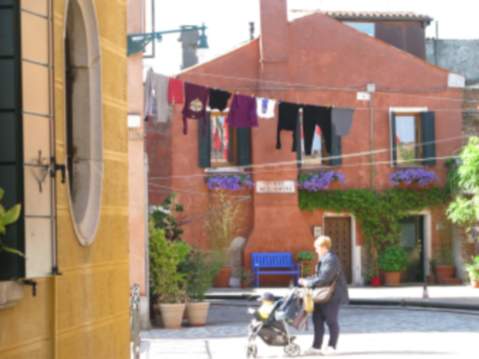
Clotheslines and gardens
It was hard to come back to earth after this trip, but luckily the earth in question is my own garden, and it needs me, so I welcome the return.
Comments
Post new comment